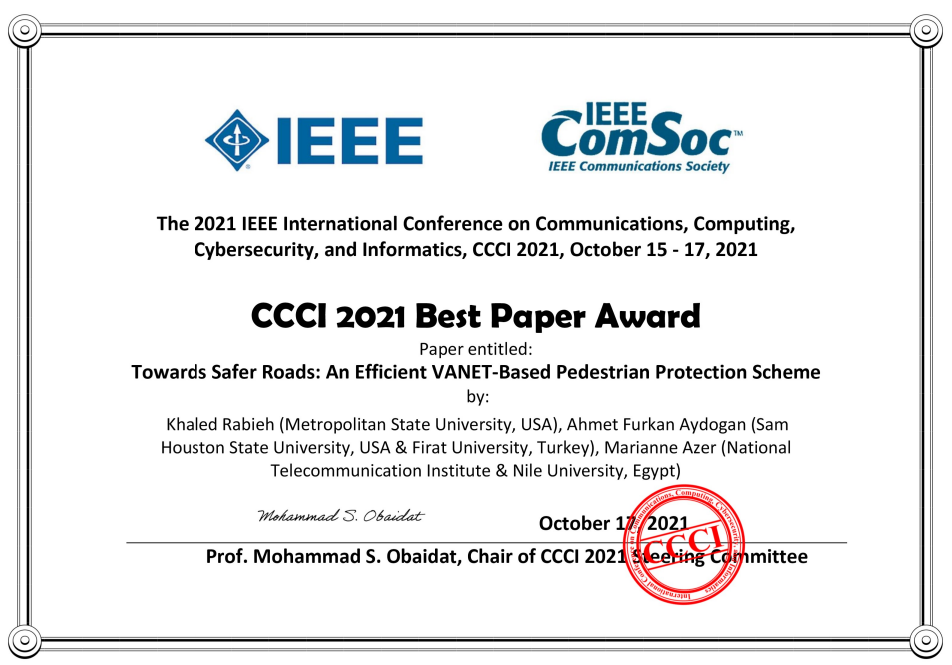Towards Safer Roads: An Efficient VANET-Based Pedestrian Protection Scheme
About 1.2 million people lose their lives on roads yearly due to accidents despite the emerging and uprising technology in contemporary vehicles. In addition, 4.4 million people were seriously injured and required medical attention in crashes last year. By employing Vehicle-to-Pedestrian (V2P) communication between drivers and vulnerable road users, fewer casualties are likely to occur and roads are expected to be much safer. In this paper, we propose a lightweight scheme to protect vulnerable road users based on communication between smartphones and on-board units installed in vehicles. Initially, the signal strength is used to estimate the distance between vehicles and pedestrians and predict the occurrence of a collision. Since signal strength alone can result in false alarms, we propose a collision detection algorithm to confirm a collision. The algorithm is run on both sides; the drivers and vulnerable road users to give appropriate and real-time warnings of a potential accident/collision. Vehicles and road users exchange their Global Positioning System (GPS) locations using Dedicated Short Range Communications (DSRC). The algorithm constructs a vector representing the vehicle path and uses efficient and simple mathematical operations to determine if there is a possibility of collision or not. Our scheme contributes to the safety applications of vehicular ad hoc networks. Our experiment’s results confirm that the proposed scheme can effectively detect collisions with minimum computation overhead.
Towards-Safer-Roads-An-Efficient-VANET-based-Pedestrian-Protection-Scheme
Prevention Pre-Violence in E-Labs with MachineLearning PVE
Digital Forensics continues to be one of the most needed areas of today. In particular, the difficulties experienced in the field of education during the pandemic period have carried the fields where training will be given to the digital parts. However, it also brought pre-pandemic concepts such as bully, violence and insult to cyber environments. Although the studies to improve the existing distance education applications generally focus on areas such as quality image and sound transfer, the ones that may cause bigger problems in the future are the acts called crime. This study aims to create a possible schema to easily complete an investigation that may arise in the future and obtain evidence by applying the Digital Forensics field, which was created to investigate cyber-crime in detail and deliver it to judicial authorities, to distance education applications called elab. In addition, it can be applied to living systems to prevent the aforementioned criminal elements. While the study is performing itself, it focuses on machine learning and natural language processing, and it is seen that it has achieved more than 90% success in small-scale experiments.
Prevention-Pre-Violence-in-E-Labs-with-MachineLearning-PVEA new Approach to Social Engineering with Natural Language Processing RAKE
Nowadays, with the advancement of technology, the way of thinking of communities has become easily manipulated. Scientific results put forward during the Arab Spring period, which is one of the biggest examples, show that social media is easily used to guide people in different ways. This paper introduces our project, Rake, which has emerged as a method against the aforementioned manipulations. The Rake used Nat-ural Language Processing and Machine Learning algorithms, to generate its own dataset and it consist of three major procedures: Emotion, Reaction, and Word Mapping, Rake is a high performance application that can adapt to areas such as community analysis, business area analysis and advertising. As shown in the experiments, it has achieved a machine learning performance of 94%. In addition, the stages that convey how to adopt the Rake application in large-scale projects were included in the study.
A-new-Approach-to-Social-Engineering-with-Natural-Language-Processing-RAKE